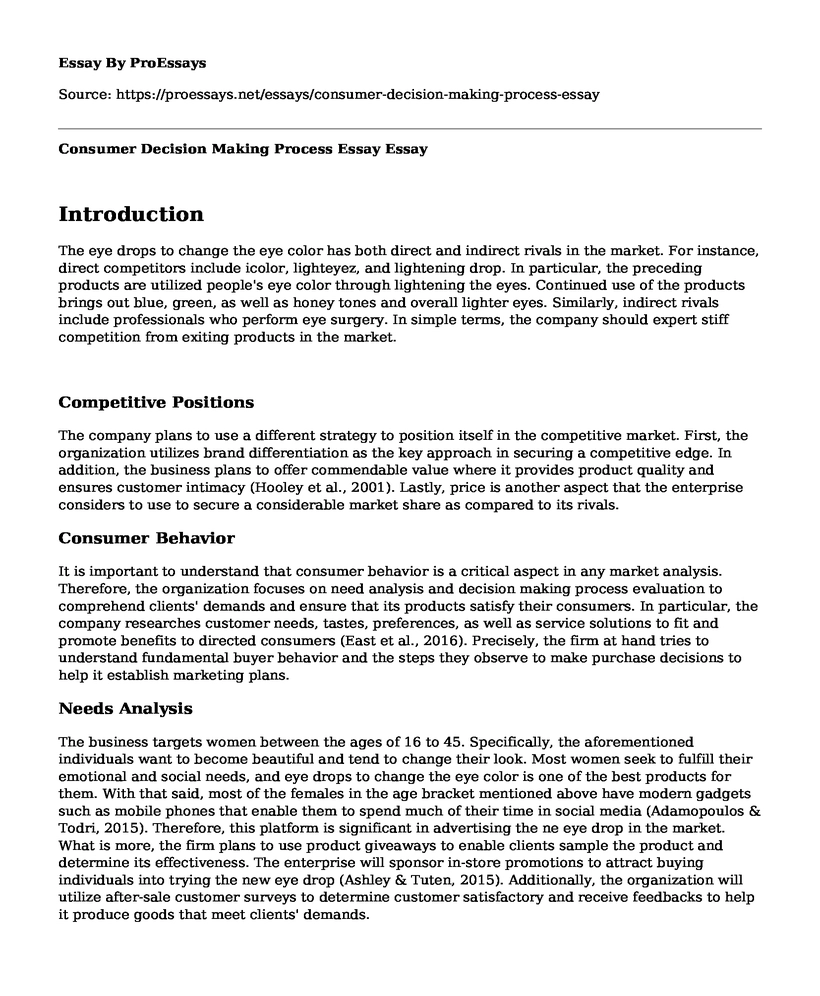Introduction
The eye drops to change the eye color has both direct and indirect rivals in the market. For instance, direct competitors include icolor, lighteyez, and lightening drop. In particular, the preceding products are utilized people's eye color through lightening the eyes. Continued use of the products brings out blue, green, as well as honey tones and overall lighter eyes. Similarly, indirect rivals include professionals who perform eye surgery. In simple terms, the company should expert stiff competition from exiting products in the market.
Competitive Positions
The company plans to use a different strategy to position itself in the competitive market. First, the organization utilizes brand differentiation as the key approach in securing a competitive edge. In addition, the business plans to offer commendable value where it provides product quality and ensures customer intimacy (Hooley et al., 2001). Lastly, price is another aspect that the enterprise considers to use to secure a considerable market share as compared to its rivals.
Consumer Behavior
It is important to understand that consumer behavior is a critical aspect in any market analysis. Therefore, the organization focuses on need analysis and decision making process evaluation to comprehend clients' demands and ensure that its products satisfy their consumers. In particular, the company researches customer needs, tastes, preferences, as well as service solutions to fit and promote benefits to directed consumers (East et al., 2016). Precisely, the firm at hand tries to understand fundamental buyer behavior and the steps they observe to make purchase decisions to help it establish marketing plans.
Needs Analysis
The business targets women between the ages of 16 to 45. Specifically, the aforementioned individuals want to become beautiful and tend to change their look. Most women seek to fulfill their emotional and social needs, and eye drops to change the eye color is one of the best products for them. With that said, most of the females in the age bracket mentioned above have modern gadgets such as mobile phones that enable them to spend much of their time in social media (Adamopoulos & Todri, 2015). Therefore, this platform is significant in advertising the ne eye drop in the market. What is more, the firm plans to use product giveaways to enable clients sample the product and determine its effectiveness. The enterprise will sponsor in-store promotions to attract buying individuals into trying the new eye drop (Ashley & Tuten, 2015). Additionally, the organization will utilize after-sale customer surveys to determine customer satisfactory and receive feedbacks to help it produce goods that meet clients' demands.
Decision Making Process Analysis
The decision making process in this case involves five stages, namely problem recognition, data search, evaluation of options, purchase decision, and post purchase evaluation. Consumers contribute in each of the aforementioned stages. To begin with, the business must identify customer needs and produce an item that solves the existing problems. Secondly, the firm should embark on information search after determining clients' needs (Dudovskiy, 2015). Notably, this level has two parts consisting of internal and external search. After collecting adequate date, evaluation of options is vital where consumers compare and analyze the information to make right choices. The clients are now in a position of making a purchase decision after reviewing all alternatives. Lastly, the company should make a post-purchase evaluation to understand customers' experience with the new product.
References
Adamopoulos, P., & Todri, V. (2015, August). The effectiveness of marketing strategies in social media: Evidence from promotional events. In Proceedings of the 21th ACM SIGKDD International Conference on Knowledge Discovery and Data Mining (pp. 1641-1650). ACM.
Ashley, C., & Tuten, T. (2015). Creative strategies in social media marketing: An exploratory study of branded social content and consumer engagement. Psychology & Marketing, 32(1), 15-27.
Dudovskiy, J. (2013). Consumer Decision Making Process: a detailed analysis. Retrieved Jan http://luxurysociety. com/articles/2013/02/how-well-do-we-really-know-the-chinese-luxury-consumerurary.
East, R., Singh, J., Wright, M., & Vanhuele, M. (2016). Consumer behaviour: Applications in marketing. Sage.
Hooley, G., Greenley, G., Fahy, J., & Cadogan, J. (2001). Market-focused resources, competitive positioning and firm performance. Journal of marketing Management, 17(5-6), 503-520.
Cite this page
Consumer Decision Making Process Essay. (2022, May 17). Retrieved from https://proessays.net/essays/consumer-decision-making-process-essay
If you are the original author of this essay and no longer wish to have it published on the ProEssays website, please click below to request its removal:
- Paper Example on Programmatic Advertising: Real-Time Marketing
- Healthcare Quality Management Paper Example
- Implementing New Technology in an Organization That Purely Uses Legacy Systems
- Research Paper on Radio Advertisements
- Essay Sample on Most Important Information in the Design of the Sales Incentive Plan
- Essay on Loyalty Rewarded: Assessing the Impact of Consumer Effort on Random Marketing Outcomes
- Essay Example on Transforming Healthcare: THS's Strategic Pursuit of Market Share







